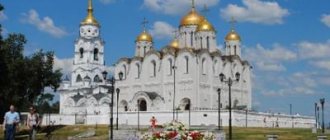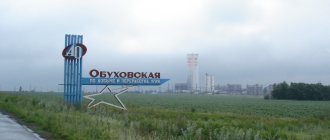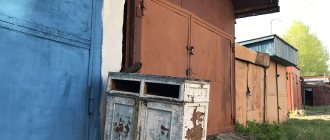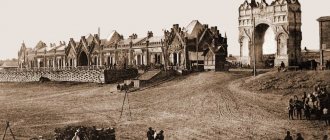Transit city: border life of Mamonovo
“Real Estate of New Kaliningrad.Ru” went towards the Polish border. But she didn’t get to the apple and sausage paradise, stopping in the small border town of Mamonovo to understand what life is like in a city whose residents have one foot in Poland.
Of course, you don’t have to go far here - the same Sovetsk generally looks out onto Lithuania. But Sovetsk, firstly, is much larger than Mamonovo; and secondly, the Lithuanian destination is not so popular in Kaliningrad, especially in the field of consumer tourism. And local border crossings, especially Mamonovo-2 - Grzechotki, opened 4 years ago, still remain the most popular border crossing point among Kaliningrad residents.
The city of Mamonovo itself somehow does not particularly indulge in a tourist program, despite its more than seven hundred year history and the presence of the Prussian sanctuary of Romove nearby. There are the remains of the Heiligenbeil church (a piece of a wall, to be more precise), several German architectural monuments, a water tower, a bust of Nikolai Mamonov, the head of Nikolai Mamonov, a mass grave of the Second World War, a First World War burial. There is the Church of the Baptism of the Lord, near which a nice alley was opened a few years ago, loudly called the “road of happiness.” There is a local history museum and, finally, a monument to sprats. Most of the city's attractions can be explored in 20 minutes at a leisurely pace. You can simply wander around the city, looking at the pompous mansions and dilapidated houses. Or get to the bay. You can’t arrange a gastronomic tour here either: on the one hand, the proximity of Poland should provide seemingly good cuisine, on the other hand, this same proximity eliminates any need for it. If you want to eat, go to Poland. Well, or to the establishment “At the Bridge”, which is quite enough for the city, apparently.
So what is Mamonovo if it doesn’t turn out to be a tourist center, or a historical or gastronomic one? It turns out to be an ordinary peripheral city with a border flavor, a population of just over 8,000 and mainly Polish goods in small shops. The gas pipeline is being built slowly, the wastewater treatment plant is going to be commissioned next year, the fish processing plant delights the townspeople with its aroma and, at times, flooding of areas. The main news that comes from here concerns either border incidents or fishermen who once again sailed into the bay.
The city welcomes and accompanies those entering with predominantly typical five-story buildings mixed with decaying German houses. Closer to the center, along the side streets, you begin to come across the private sector: from simple houses (all the same “Germans,” for example) to huge palaces with impenetrable fences and incredible architectural twists. The main infrastructure facilities are concentrated in the center, some of which, by the way, occupy historically designated buildings (for example, a post office or a hospital), which still does not happen very often in our region. The memorial at the mass grave seems to be the center of the city’s evening cultural life: young people with low-alcohol drinks are making noise on wooden benches; nearby, on a similar bench, old women are discussing something, romantic couples and noisy groups are scurrying back and forth across the square, or simply discussing something, standing in a tight circle. Move a little towards the peripheral streets and you will encounter an almost unnatural silence and emptiness. Narrow broken sidewalks, rare passers-by, fences.
A square meter for those wishing to live on the border with Poland will cost approximately 30,000 rubles. There are no new buildings here, except for the German barracks restored about 10 years ago, which are now called the Admiral residential complex. You can even buy a modest house here for 1.5–2 million. Or maybe a palace for 18 million rubles. It's a matter of taste and wallet.
But in general, for some reason there is almost nothing to tell about Mamonovo. Thousands of people rush through it on the way to the treasured Poland, and in the end there is a feeling that for the townspeople themselves, Mamonovo is nothing more than a transit point or a temporary accommodation base between trips to Europe. Sad and empty city. With the sprats monument as the main attraction.
Text - Tatiana ZIBEROVA, photo - Vitaly NEVAR
Heiligenbeil translated means “sacred axe.” Let’s try to figure out why the name and coat of arms of the current Mamonovo contain the word “axe” and its image.
Researchers associate the ax with the legend that during the confrontation between the Prussians and the Teutonic Order, statues of pagan gods were chopped up with just such an ax.
Long before the appearance of the order, at the confluence of the Yarft and Banava rivers (present-day Vitushka and Mamonovka), here, on a hill, was the Prussian settlement of Sventemest, or “sacred settlement”, and the Svetopil fortress - “holy mountain”. Why sacred? Because nearby is the Romove forest, where there was an open-air sanctuary, the cult center of all Prussians. It is tentatively dated to the 5th-10th centuries. n. e. The area of the temple is impressive - 205x182 meters. In the center stood an oak tree (6 cubits in diameter) with a crown so thick that it did not allow even a drop of rain to pass through. Medieval authors reported that the tree was evergreen and remembered the first king of the Prussians, Widevut. Rituals, sacrifices to the three main gods (Perkuno, Potrimo, Patollo) and holidays were performed at the oak tree. Later, the temple was moved to Nadravia, due to the campaigns of Boleslav the Brave, undertaken at the beginning of the 11th century in revenge for the death of St. Adalbert.
But, as they say, a bad peace is better than a good quarrel. And in 1249, the Treaty of Christburg was signed between the Prussians and the Teutonic Order, which in particular stipulated the construction of the church. To put an end to the pagan beliefs of the Prussians, the sacred oak was destroyed by order of the Sambian bishop Anselm.
But the agreement did not bring the expected peace - the settlement passed from hand to hand, from the Prussians to the order and vice versa, over several decades of the 13th century. Around 1272, the order built a wooden fortress on this site, which in 1301 was already mentioned as the city of Heiligenstadt - the “holy city”, which has Kulm law (a public legal act establishing legal norms for the relationship between citizens and the Teutonic Order). This name appears in written sources from 1330 and on an ancient city seal in Latin - “Sancta Civitas”. To protect the city, a fortress wall was erected. Its lower part was made of wild stone, and the upper part was made of brick, lined with Gothic masonry (part of this wall can still be seen). They dug a deep ditch. The Yarft River was divided into two branches by a dam, thanks to which a water mill appeared (now there is a hotel in its place).
In 1344, the city received the name Heiligenbeil (“bil” - fortress, castle in Old Prussian), and later - Heiligenbeil (“beil” - axe), presumably in memory of the ax that cut down the sacred tree. By the way, in Polish it sounds like “Święta Siekierka”. This “Siekierka” became the symbol of the city.
Near the fortification there appeared a village with 63 plots of land, a church (1349) and a school, which was mentioned in 1409. From 1372 to 1520, there was an Augustinian hermitage here, founded by Grand Master Winrich von Kniprode.
In general, the history of the city is closely connected with the history of the Teutonic Order. For example, in the Battle of Grunwald on July 15, 1410, several detachments from Heilingenbeil took part as part of the troops of the commander of the Order of Count von Zollern. The flag of one of these units was kept for a long time in the Krakow Cathedral as a military trophy.
In 1440, Heiligenbeil became a member of the anti-Order Prussian League. In response, the order occupied the city in 1445. In 1462, Jan Waldstein, who led the troops fighting against the crusaders, destroyed a suburban settlement and burned the city itself in 1463. But the Teutons returned here already in 1464 and placed a garrison here for the Livonian branch of the order. And finally, in 1510, it was in Heiligenbeil that representatives of the highest circles of the order and bishops gathered to elect the last Supreme Master - Albrecht Hohenzollern.
The sixteenth century brought disaster to Heiligenbeil. In 1519, a fire destroyed almost the entire city. In 1520, the Poles captured it and destroyed the monastery, which was never restored due to lack of money. In 1522, the rights and possessions of Heiligenbeil were documented to replace the lost charter about the founding of the city. In 1560, the Kulm law was confirmed. In 1563, Duke Albrecht founded the St. George's Asylum on lands that previously belonged to the monastery (later, in 1865, the orphanage would be moved to a new building, now the dormitory of the fish canning plant or the Trading House).
The seventeenth century also turned out to be of little joy for the inhabitants of this area. During the Thirty Years' War, Heiligenbeil was occupied by the Swedish army for many 50 years. The plague epidemic of 1629 claims the lives of many townspeople. The fire of 1677 destroyed most of the city, including the church, town hall and school.
The beginning of the 18th century was marked by the plague, which killed 1,147 people between 1709 and 1710, and 1,443 in 1750. During the Seven Years' War, Russian troops were stationed here, and in 1758 the population swore allegiance to Empress Elizabeth Petrovna. Prussia became part of the Russian Empire for four years.
Despite everything, the city developed. So, in 1736, a fair was transferred here from Bladiau (now the village of Pyatidorozhnoe, Bagrationovsky district), which was held three times a year. The Heiligenbeil woodturners were famous for their juniper products (mouthpieces, cups, etc.), which were widely sold far beyond Germany. Heiligenbeil beer and white bread were also famous. The beer was so good that in the 17th and 18th centuries, some Polish cities were forced to veto its import in order to prevent the ruin of their own brewers. By the way, only selected townspeople could brew beer, and their activities were strictly regulated. It was clearly written down who was cooking it, when and in what order. “Martovskoye Solenoye” was in particular demand.
In the 18th and early 19th centuries, many famous people passed through the city, whose names are familiar to you. This is the architect V.V. Rastrelli, and M.V. Lomonosov, and the last hetman of Ukraine K.G. Razumovsky, and A.N. Radishchev, and D.I. Fonvizin, and P.G. Demidov, and M. I. Kutuzov, and the future Empress Catherine II.
Fires in the city continued into the 19th century, for example, the fire of September 1806. A little more than a year passed and the fire of December 1807 destroyed 421 houses with outbuildings, 12 granaries, fair pavilions, gates and the town hall. And then there was the war with Napoleon. King Frederick William III of Prussia and Emperor Alexander I of Russia held a review of troops in the city in May 1807. But in June 1812, confident of his victory over Russia, Napoleon and his retinue marched through Heiligenbeil, not knowing that very soon he would have to flee in the opposite direction, losing his army. Residents of the city warmly greeted Russian soldiers who were pursuing the French, helping them with food and clothing...
In 1819, after the administrative reform of East Prussia, the district headquarters was located in Heiligenbeil, which served as an additional impetus for development. Having become a regional center, the city acquired a lot. In 1826, direct access to the road to Berlin appeared, and in 1853 the Königsberg-Berlin railway line ran through the city. In October 1879, an agricultural school was founded in Heiligenbeil. Dozens of buildings were built, including: a post office (1885), a hospital (1887, still in operation), and a Catholic church (1891). And in 1895, the Ostdeutschen Maschinenfabrik began its work - a factory that produced agricultural machines and tools. By the beginning of 1900, 3,800 people lived in the city, some of whom were employed in the textile and metallurgical industries.
In 1910 there were already 4821 inhabitants. There was a partnership of gardeners and gardeners, whose members developed new varieties of vegetables and fruits to supply the city.
The First World War spared Heiligenbeil. There were no military operations in the city or near it, but in the local cemetery there are graves of 12 Russian soldiers who died in captivity from their wounds.
By 1930, Heiligenbeil boasted a gas works, a brewery, a steam sawmill, a dairy, a furniture factory, a mill, a light materials processing plant, a pudding powder factory, railway workshops, financial institutions, a court, a cadastral office, a district peasant association, and a city public school. with a gym, music and summer schools, the Heiligenbeil Zeitung newspaper and much more that a real city should have. In 1931, the city community included 6 suburban settlements. In 1935, the fishing village of Rosenberg was added along with piers (now the smoking shop of the Mamonovsky fish canning plant is located here). By 1939, over 12 thousand people already lived in the city, there were three schools, a hospital, a bakery, a dairy factory, horse breeding and beekeeping enterprises, an engineering plant, a steel foundry, a brick factory, an aircraft repair plant, a music school, a Luftwaffe school, and a cinema.
In 1936, a military garrison appeared in Heiligenbeil, for which barracks were urgently built, and with them an aircraft repair plant and an airfield (later the French pilot of the Normandie-Niemen regiment, Francois de Joffre, would describe it as a “first-class aviation base.” In Heiligenbeil French pilots from "Normandy" celebrated Victory Day). The city, according to the plans of Hitler and his entourage, was supposed to become an impregnable stronghold, because the territory of Prussia was considered as a springboard for the invasion of Russia, but the result turned out to be different. In February-March 1945, fierce battles took place here between two powerful groups - the 3rd Belorussian Front and the 4th German Army, which defended the approaches to the port of Pillau. The city was badly destroyed and was a smoking ashes. Only 198 habitable houses survived. In ruins there were machine-building and furniture factories, a gas plant, a transformer substation, an oil plant, and the Germans dismantled a sawmill and an aircraft repair plant.
In November 1945, a customs post was established here. In June 1946, the work of the water supply system and the mill were restored, the military trade store was opened, and a little later - a seven-year school and a reading hut, a hospital, a sewing and shoe workshop, and a point of the regional office "Zagotzerno".
The first settlers arrived in September 1946 from the Kuibyshev region, followed by them from the Gorky, Tambov, and Rostov regions. The Decree of the Presidium of the Supreme Soviet of the USSR dated July 25, 1947 changed the name of the city. He was named after the Hero of the Soviet Union, Lieutenant Colonel Nikolai Vasilyevich Mamonov, commander of the 331st Infantry Regiment, who took part in the assault on Heiligenbeil and died during the fighting in Poland. This year, 2948 people already lived in Mamonovo, of which 950 were Germans. The city-forming enterprise to this day, the Mamonovsky Fish Factory, appeared in 1949; later, in 1953, it was renamed the Mamonovsky Fish Canning Plant. In the first post-war years, the Pobeda collective farm also appeared.
Gradually Mamonovo changed for the better. In 1951, an international border crossing was opened, connecting the Kaliningrad region with Poland, and through it with European countries. In 1953, the reconstruction of the railway station was completed. Nurseries, kindergartens, shops, the Rodina cinema, a fishermen's club, evening and music schools appeared. In 1961, the Mamonovsky animal farm appeared, which was engaged in raising mink, arctic fox, nutria, ferret, and sable. Furs were supplied to auctions in Leningrad, London, and Helsinki, where the products were repeatedly awarded honorary diplomas and prizes, including the London Auction Challenge Cup.
The 90s were difficult for Mamonovites, as well as for residents of the whole country. They were saved by their proximity to the border and the developing “shuttle” business. But it was during these years that an exhibition hall with materials on the history of the city of Heiligenbeil opened in the city administration building, which existed until 2007.
The fishing industry and fur farming have long been the city-forming sectors of the Mamonovo economy. Now, previously uncharacteristic production for the area has appeared here, for example, baby food and chocolate glaze. In 2008, the city won the competition for the title of “The most comfortable city and village in the Kaliningrad region with a population of less than 20 thousand people.”
The city, rebuilt after the war, is located slightly northwest of its pre-war location. Since there was nothing to restore here, there are not many attractions. This is the already mentioned part of the fortress wall, destroyed during the Franco-Prussian War of 1806-1807 and never restored.
A memorial stone with information about the naming of the city after N.V. Mamonov. This boulder, weighing one and a half tons, is interesting because it was bought by the city from farmer Robert Gesin for 30 marks and installed in memory of Prussian Chancellor Otto von Bismarck, who died in 1898. After 1945, the bronze bas-relief of the unifier of Germany was knocked down and the current information appeared on it.
The ruins of the church, which was badly damaged during World War II, was finally destroyed in 1980.
Monument to sprats, a Soviet-era delicacy. Opened in 2008 on City Day in front of the House of Culture.
The post office building, an architectural monument of the late 19th century, contains on the foundation stone the date of the start of construction and the initials of the owner of the agricultural machinery plant, Rudolf Wermke, who built it with his own money. This is the so-called “brick neo-Gothic” with relief masonry, turrets and wrought iron elements. The facade was decorated with a clock and the roof was tiled.The water tower of 1901 is, like the post office building, a monument of “brick neo-Gothic”.
“Koch Pots” are concrete firing points installed in 1944 by order of E. Koch at key defense points of populated areas and intended for firing by two machine gunners. One is located at the entrance to Mamonovo, the other is on Pogranichnaya Street.
A memorial stone in honor of the 700th anniversary of Heiligenbeil - Mamonovo (1301-2001) with touching verses: “... A land with a double history, The ruler of our destinies - A land wounded by war, Revived from the ruins!”And also a memorial complex, a monument to N.V. Mamonov and the Motherland.
N. Gora
See also:
Mamonovsky City Museum








